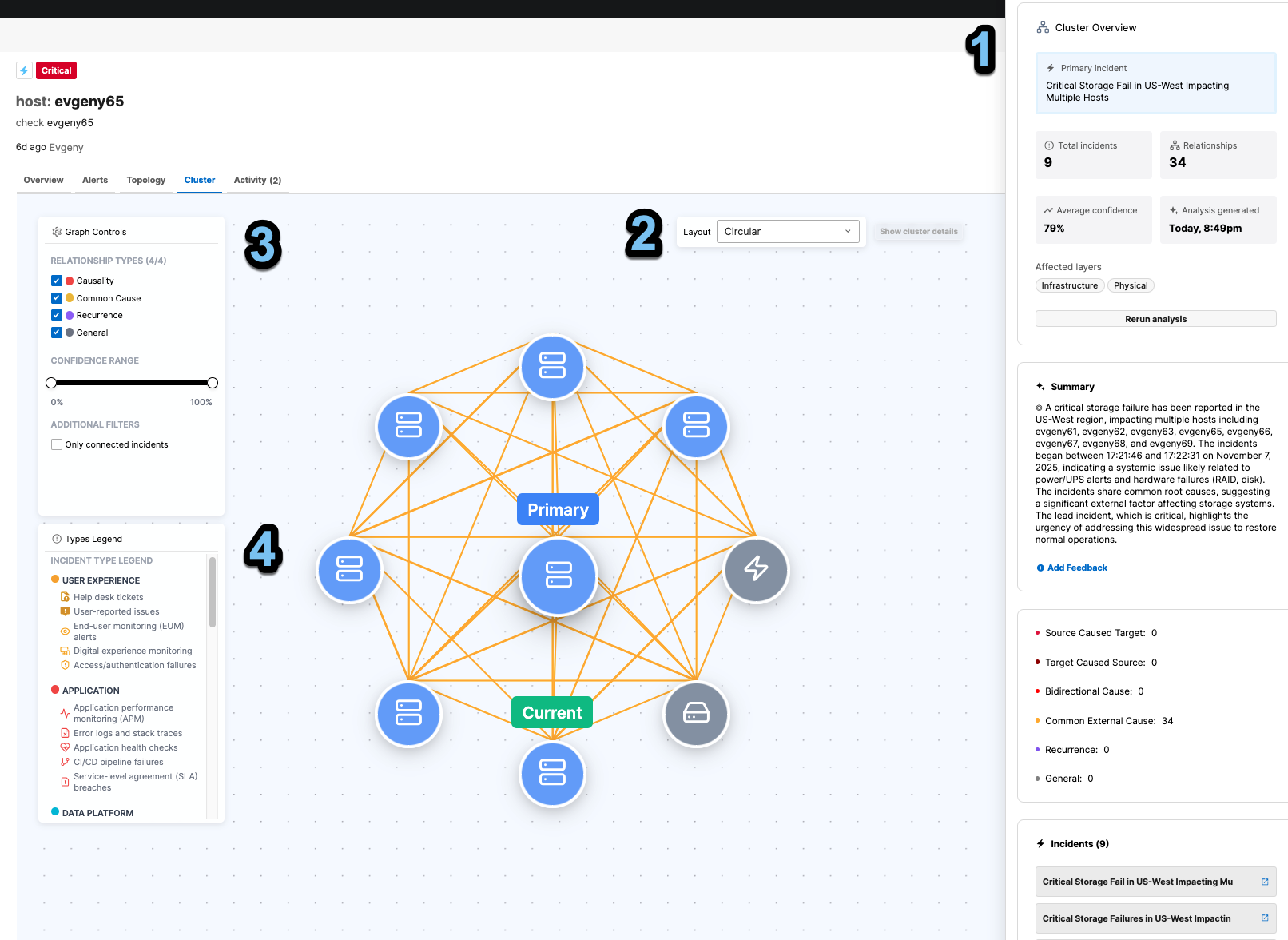Incident Correlation
Use BigPanda to automatically cluster related incidents based on shared attributes, infrastructure dependencies, and behaviors. You can run cluster analysis for specific time periods or view live correlation analysis for active incidents. This accelerates root cause identification and provides a clearer look at what’s happening in your environments.
This feature leverages the IT Knowledge Graph and AI to detect patterns across high-volume alert streams—identifying when multiple seemingly separate alerts are actually part of the same larger incident.
Assistance required
Enabling Incident Correlation requires close coordination with the BigPanda team. Contact your BigPanda account manager if you’d like to enable this feature.
Key features
AI-powered analysis: BigPanda uses generative AI to analyze data from multiple data sources and infrastructure points to provide you with a comprehensive look at your incident history.
Accelerated root cause identification: Incident clusters make it easier to identify root cause and recurring issues.
Visualize downstream effects: Get a clearer picture of incident impact using interactive topology maps.
How to use incident correlation
Incident correlation generates incident clusters based on AI analysis of both live and historical incidents. These clusters show the relationships between similar incidents, suggest root causes, and categorize incidents based on their type. They can be generated for both live and past incidents.
To generate a cluster for a live incident, use the Cluster tab in the incident details pane. This cluster will only cover incidents that are correlated to that specific incident at the time that you open the tab. This cluster will be cached for several hours, so if you want to update the cluster, you will need to click Rerun analysis. This will generate a new analysis of the incident and may return different results based on new data.
Processing time for live incidents
Depending on how many incidents need to be correlated, it may take several minutes to finish generating an incident cluster. Partial results will be available within a few seconds, and results will be auto-updated until the analysis is successfully completed.
To run correlation analysis for all incidents in a specified time period, use the Incident Correlation tab in the incident console and create a new report. This will correlate all incidents during that time period into clusters that can then be analyzed individually.
Incident relationships
There are six different relationships that may occur between incidents:
Source Caused Target: The source incident is assessed as upstream cause of the target.
Target Caused Source: The target incident is assessed as upstream cause of the source.
Bidirectional Cause: Mutual causality/feedback loop, represented with links in both directions.
Common External Cause: Incidents share the same upstream external factor (non-directional).
Recurrence: The same or highly similar incident repeating at a different time; for recurrence-only clusters, the oldest occurrence is chosen as the primary by default.
General: Strongly related incidents (semantic/topological similarity) without asserted causality or recurrence.
Historical incident correlation reports
To create a new incident correlation analysis and view existing reports, navigate to the Incident Correlation tab in your BigPanda instance.
On this page, generate a new analysis by clicking + New Analysis Request or click the dropdown to view previous analysis periods.
Create a new incident correlation report
Create a new cluster analysis by navigating to Incident Correlation > + New Analysis Request, then define the time period you want to analyze.

Field | Description |
|---|---|
1 - End date and time | The end of the analysis period. |
2 - Look back period | The amount of time before the end date that you want to analyze. You can set a custom time range or choose from:
|
3 - Minutes | If you selected a custom look back period, define the amount of time in minutes that you want BigPanda to analyze. (For example, if you wanted to analyze three days, you would input 4320 minutes.) To optimize data accessibility and accuracy, we recommend that you cover no more than 1-2 days in one report. |
4 - Selected analysis period | A confirmation of the days and times you set as your start and end dates. Note that date/time defaults to UTC time zone. |
5 - Custom label | The name that will appear next to the analysis period in the results dropdown. |
6 - Advanced edit | A customizable JSON script where you can view advanced settings for clustering. This should only be configured by your BigPanda account team. Coordinate with your team to explore customization options. |
Processing time
Once you create a request, it could take anywhere from 15 minutes to a few hours for the analysis to be available. This is affected by several factors, such as the amount of data customers have, the configuration of the algorithm, and the lookback period.
View cluster analysis results
Generated cluster analyses can be viewed in the Incident Correlation tab. Select a desired analysis from the dropdown The title of each analysis shows both the custom label and time period.

Each analysis lists a table of all the clusters generated during the selected time period. Select one of the following columns to sort the results by that metric.
Importance: An AI-generated score calculated from the priorities of the correlated incidents.
Incidents: The number of incidents included in this cluster.
Edges: The number of relationships between incidents.
Causation Edges: The number of causal relationships in a single cluster.
General Edges: The number of uncategorized relationships between incidents.
This table also provides an AI-generated summary of the correlation analysis. You can easily copy and paste this into another program by clicking the copy icon on the right side of the column.

